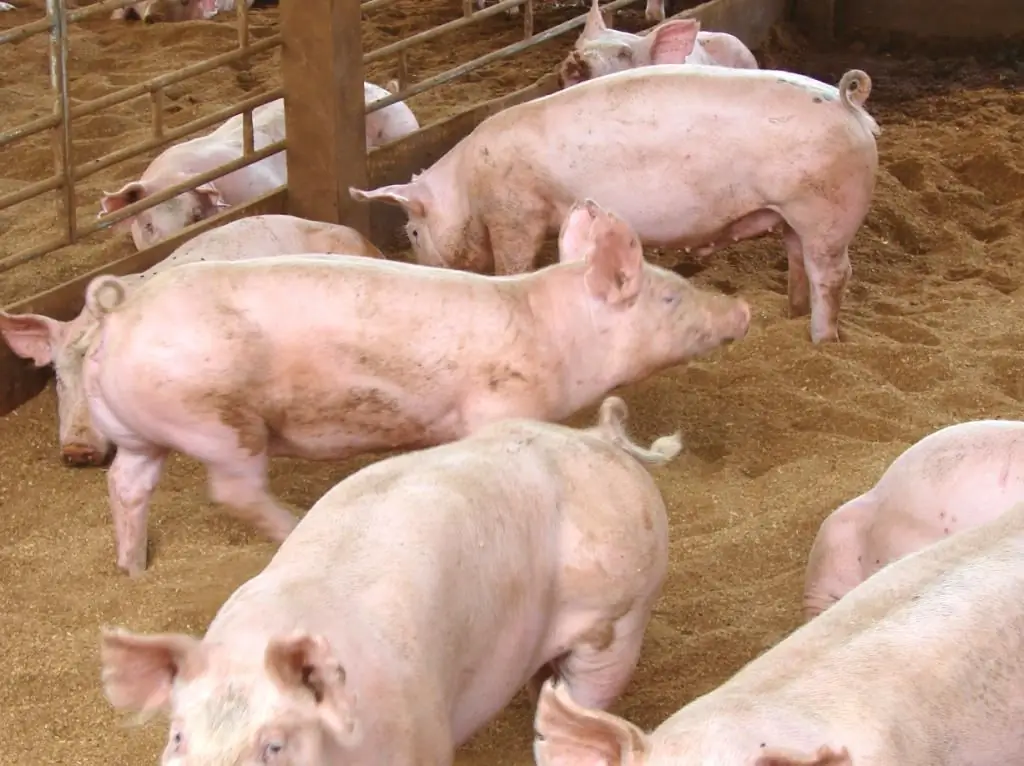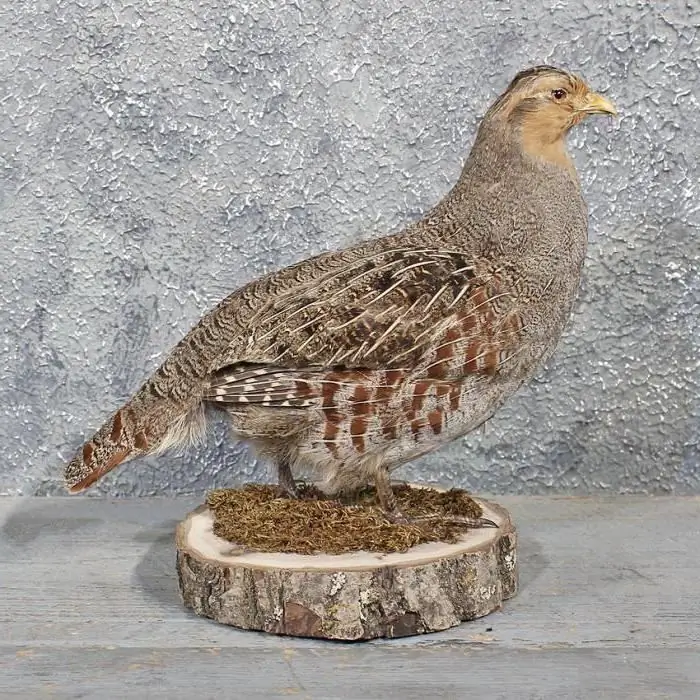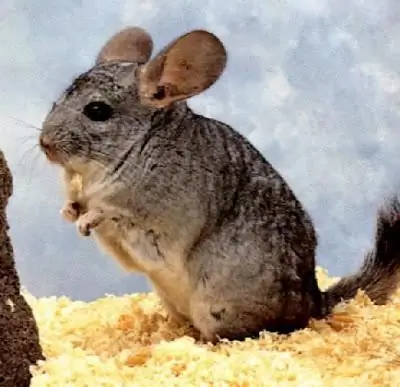2026 Author: Howard Calhoun | [email protected]. Last modified: 2025-01-24 13:10:43
Mink keeping can be a really profitable business. There are not so many farmers in our country who breed these fur-bearing animals. At present, there are only about 30 farms of this specialization in Russia. In principle, the maintenance of such fur-bearing animals is a relatively simple matter. However, successful breeding of minks in Russia, as in any other country in the world, is possible, of course, only if the farmer has certain knowledge and skills.
Value of mink skins
Currently, farms specializing in growing these animals are the main suppliers of material for the country's fur industry. It is the mink that most often goes in Russia for tailoring fur coats, hats, collars, scarves and even mittens. The demand for such fur is actually very high. This is explained primarily by its truly unique qualities.

In the wild, minks, which must be bred and maintained, of course, taking into account the biological characteristics of their organism, live mainly in the northern regions of Russia. Thick fur helps these animals to keep warm in winter. Between the hairsanimal skins create a thick air layer that does not let the cold through. However, density is not the only advantage of mink fur. All hairs of the skin of these animals have exactly the same length. Therefore, mink fur looks velvety and noble.
The price of one such raw skin is about 120 rubles per 100 cm2. But this figure is, of course, approximate. The real cost of mink skins depends on two main factors - the quality of the fur itself and its shade.
Breeds and varieties
Most often in artificial nurseries, including in Russia, Scandinavian mink is kept. Breeding it is a simple task, since this variety is very unpretentious. In the wild, there are only two groups of minks - European and American. Scandinavian, in fact, is a variation of the latter. As for the breeds, their breeders bred just a huge amount. On farms, for example, mink can be bred:
- piano-pastel (brown);
- Finnish topaz (light brown);
- American palomino (beige) etc.
In particular, silver-blue, sapphire, iris and the like are considered valuable breeds among farmers. The skins of rare white hetlunds are also very expensive. Breeding mink at home will be most beneficial when choosing blue and white breeds. But the purchase of such manufacturers will cost, of course, more expensive.

What you need to knowbeginner farmer
They keep minks, like rabbits, most often in cages installed in special open spaces - sheds. The latter are, in fact, a simple canopy without any fence. In winter, minks should be kept in conditions as close to natural as possible. That is, simply put, in the cold. Otherwise, their fur will not be so beautiful and thick. Since these animals live in burrows in the wild, small insulated houses are installed in each cage for them.
Unlike the rabbit, the mink is a carnivorous animal. This, of course, should be taken into account when choosing feed. As the latter, farmers usually use fish, meat and chicken waste mixed with various premixes.
Minks breed fast enough. A good female can bring up to 16 cubs at a time. But most often there are 5-7 babies in the litter.
How to make calculations
Mink farming will only be successful, of course, if the entrepreneur first draws up a detailed business plan for the farm. The initial capital of those wishing to organize such an enterprise should be large enough. The construction of the shed itself will not cost too much. But for manufacturers, of course, you will have to pay a tidy sum.
It is believed that breeding mink at home as a business can only be profitable if the farm contains at least 20 females. The cost of one such individual of the usual brown color is approximately 3000 rubles. For each male, you will have to pay about 2300 rubles. Suchproducers on the farm, of course, should be several. In one day during the rut, the male can cover no more than three future queens. Thus, a novice farmer will have to spend at least 60-70 thousand rubles just for the purchase of producers.

Food for minks, of course, will also be quite expensive. In fact, the success of the enterprise will depend on whether the farmer manages to find their cheap supplier or not. Most often, entrepreneurs involved in breeding minks enter into agreements with poultry farms for the supply of offal. Calculations should be made based on the fact that one female should receive 40-60 g of meat with bones per day, and a male - 60-80 g.
Very often, farmers add mink and fish to feed. This allows you to somewhat reduce maintenance costs. However, when using such an additive, it should be borne in mind that its total share in the diet of animals should not exceed 40%.
Where the mink farm should be located
When choosing a place to build a shed, an entrepreneur should, of course, comply with certain SES standards. Of course, a mink is not a pig. But the smell from a farm that specializes in breeding these animals can be quite unpleasant. According to the regulations, if the farm contains up to 50 females, the distance from it to the nearest residential building should be at least 30 m. With a larger number of animals, this figure increases to 60 m.
Of course, you should build a shed where possibleconnect to power lines. Also, the farm will need a large amount of water. Therefore, choosing a shed is a place where it does not lie too deep. In this case, drilling a well will cost less.
Of course, the farm should be located in a place with convenient access roads. After all, breeding minks involves the delivery of a large amount of feed, hay, sawdust, etc. to the farm. Also, skins will need to be taken out of the farm.

Construction work
To build, in fact, the shed itself, of course, will not be difficult. To build this structure, you just need to put up pillars and cover them with a two- or one-slope canopy. However, a shed is not the whole farm. A novice fur breeder will also need to build structures designed for slaughtering animals and storing equipment and feed. You will also have to build a small quarantine block.
If the farm contains 20 animals, the owner will, of course, be able to take care of them on his own. For more animals, you will most likely have to hire additional staff. In this case, the farm will need to provide, among other things, a change house with a changing room and a shower room.
Breeding minks at home: what should be the cells?
The size of the shed, of course, will depend primarily on the number of animals grown. Cells in such structures are installed close to each other, in one tier, in several rows. The sizes of such dwellings for minks can be different. But in any case, the cell lengthshould not be less than 70 cm, and the width - 30 cm. The most comfortable frame height for a mink is 45 cm.
In most cases, farm owners purchase ready-made mink cages. However, if desired, such equipment can be made independently. They make cages for these animals from timber and metal mesh with a cell size of 25x25 mm. Mink houses are most often knocked down from boards or plywood. A feeder and a drinker are hung on the door of each cage.
Minks are not afraid of the cold. However, in order for the animals to feel comfortable, bedding must be placed at the bottom of each cage. It is usually made from an equal amount of wood shavings, hay and straw. In the future, the litter, of course, will have to be changed periodically. On average, one mink requires about 40 kg of a mixture of hay, straw and shavings per year.
Features of mink feeding
Cultivation of mink as a business will bring tangible profits, of course, only if the animal's diet is properly developed. Meat and fish of any kind are given to these animals exclusively with bones and veins. Adult animals are usually fed twice a day. Young animals are given food 3-4 times a day. The simplicity of feeding minks lies primarily in the fact that these animals never overeat. You should not be afraid to overfeed them.

In addition to fish and poultry waste products, minks can be given specially prepared factory-made dry food, beef, lamb, game and mice. Do not feed sausages to these animals,sweets, s alty foods, canned food, citrus fruits, dairy products, and anything fried. Only sea fish can be given to minks.
Reproduction of animals
Mink breeding will not be successful if the owner of the farm does not take care of periodic renewal and increase in his livestock. The mink rut begins in March. It is possible to determine that an individual is ready for mating by its characteristic rumbling. The mating of these animals is allowed from the age of 11 months. The offspring of the queens, covered in March, appears by the beginning of May. During pregnancy, females eat much more than in the normal state. This, of course, must be taken into account by the farmer. If a pregnant mink does not receive enough nutrients and vitamins, her cubs will be born weak and sickly. It will be impossible to get good skins from them in the future. Pregnant minks should be fed ad libitum. Of course, you need to pay maximum attention to the development of the menu of male producers. It should be as varied as possible.
The owners of mink farms usually start preparing for childbirth from April 15th. At this time, the females' houses are cleaned, treated with flea products and disinfected. Next, a larger mixture of hay, straw and sawdust is placed in the female's cage.
Mink babies are born completely naked. They begin to acquire valuable fur only after some time. Therefore, the female house in the cage must be well insulated. Only in this case, breeding mink at home will be successful. In a cold nest, puppies can easily catch a cold and die.
Care for young animals
At first, mink puppies feed exclusively on mother's milk. The eyes of the cubs open approximately on the 25-30th day. On the 20th day, the teeth erupt in puppies. It is by this time that well-chopped food on a small metal plate should begin to be placed in the cage. The uterus will independently carry it to the babies in the nest.
When the puppies are one month old, the female will start pulling them out to the feeder. After a while, the cubs get used to going to the tray themselves.

At 5-7 weeks of age, mink puppies become very voracious. If they do not have enough food at this time, they can gnaw each other or even kill and eat the female herself. The owner of the farm must take this into account, of course, without fail.
The young mink's lunge is usually small. Some puppies die mostly only in the first week after birth.
Young minks are removed from the uterus most often at the age of 1.5 months. Cells for young animals are prepared in advance. Puppies are seated one by one or in pairs. Minks born in May are usually slaughtered in November.
Possible profit and feedback
You can get income from a farm of this specialization mainly in two ways - by selling animal skins, as well as thoroughbred producers. Some owners of mink breeding farms also sell some of the young as pets. With the right organization of the farm, mink breeding can bring really big profits.
Cost calculation exampleand income
So, how profitable can a mink farm be? Further, for clarity, we present to the reader's attention a few figures for a nursery for 240 females and 60 males. The organization of the farm in this case usually costs about 4,200,000 rubles. At the same time, annual expenses amount to about 2,891,000 rubles. Skins and producers for the year in such a nursery can be sold for about 4,000,000 rubles. Thus, the farmer's net profit is 1,109,000 rubles/year.

Instead of a conclusion
Of course, 240 heads of females is a lot. In most cases, entrepreneurs initially purchase much fewer manufacturers. But even a farm of 20 heads can become quite profitable. It is believed that with just one pair of minks, you can get up to 120,000 rubles of income per year. Thus, this business is really quite profitable - breeding minks as a business. Reviews of such farms, of course, are mostly only good. But, according to farmers, efforts to maintain such a nursery will have to be made very, very much. Otherwise, of course, it will not work to make a profit from breeding minks.
Recommended:
Pig breeding at home - features, breeding and maintenance

How to start pig farming at home. What is the profitability of this business. How to equip pigsties. The right choice of breed and the acquisition of piglets. What to consider when writing a business plan. Pig diseases. Getting offspring
Breeding turkeys: a business plan. Turkeys: breeding, growing conditions, breeds (photo)

Turkeys, which are not commercially bred for eggs, are characterized by rapid growth with minimal feed costs
Ostrich breeding at home. Business plan for breeding ostriches

Ostrich breeding is quite profitable and not too troublesome business. The unpretentiousness of birds in care and the high cost of ostrich products are exactly the factors that can push the farmer to a new occupation for himself - breeding ostriches at home. How to start breeding ostriches? What needs to be done first? How much will it cost?
Partridges: breeding and keeping at home. Breeding and keeping partridges at home as a business

Breeding partridges at home as a business is a wonderful idea, because so far it is exotic to some extent, does not require significant investments at the start (or even none at all), there is no special knowledge for growing an unpretentious and little sick bird need. And demand today exceeds supply. This business can be especially interesting in small towns and villages where there are problems with employment and other types of earnings
Chinchilla breeding as a business: growing, keeping, breeding at home

Our planet has long been inhabited by thousands of species of living beings and plants, many of which are still not studied or poorly studied. Species that have gained particular popularity among humans are listed in the Red Book

